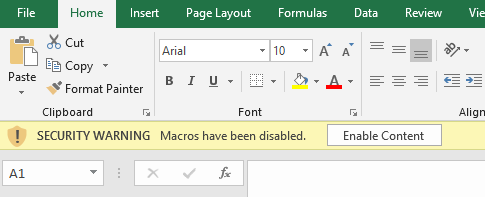Macros are short snippets of code that can be embedded within Microsoft Office documents. Macros were invented by Microsoft to support adding exciting and powerful features to Word documents, Excel spreadsheets, and other types of Office documents, but in practice, they are often abused by bad actors to deliver malware to unsuspecting victims through trojan Office documents.
The IT department advises extreme caution whenever you interact with macro-enabled documents! If you don't know or trust the sender of the file, you should never enable macros in an Office document.
Macro Warnings
When opening an Office document that includes a macro, you may see a warning like the one below if you downloaded the file from the Internet (email, Box, etc).

If you see a warning like the one above, please forward a copy of the file to the Information Security Manager at infosec@sou.edu. If the file is determined to be safe and the macros are important, we will help you enable macros in the document.
When opening an Office document with macros unblocked, you will see a warning like the one below. Typically macros will be unblocked when the file originated from somewhere other than the Internet. You can use the Enable Content button to enable macros in the document, but be careful! If you don't know the nature of the macros in the file, please forward a copy to infosec@sou.edu and await instructions from us.

Employees can also count on their Computing Coordinators for help with these messages, and you can call our IT Helpdesk at 541-552-6900 if you need a rapid response.


Add a comment
Please log in to submit a comment.